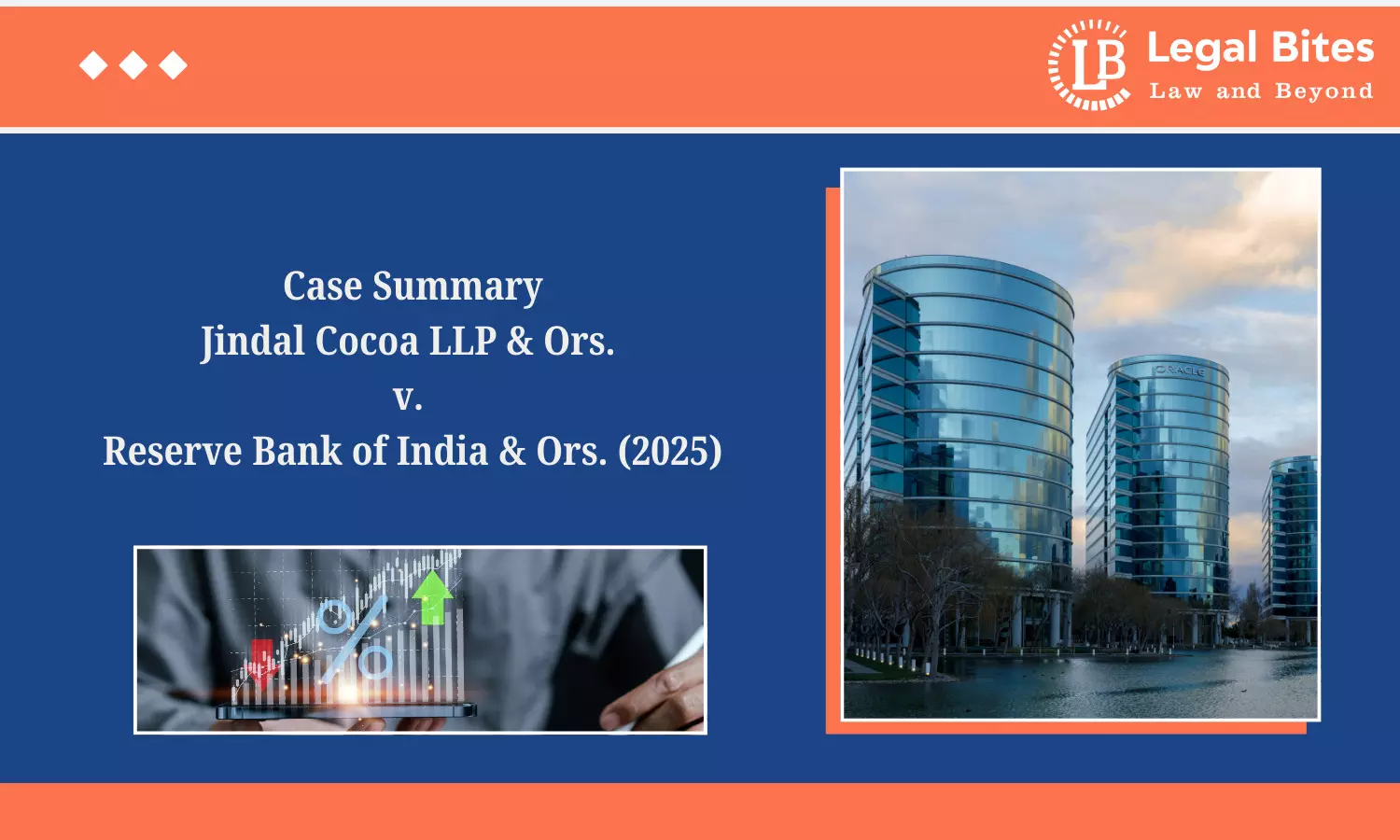Case Summary: Jindal Cocoa LLP & Ors. v. Reserve Bank of India & Ors.(2025) | Bombay High Court on Export Credit
The Bombay High Court’s decision offers a balanced approach to the interpretation of export credit regulations.

This writ petition challenges the interpretation of the Reserve Bank of India’s (RBI) Master Circular on Rupee/Foreign Currency Export Credit & Customer Service to Exporters (July 1, 2015) by the Banking Ombudsman (Respondent No.3) and HDFC Bank Ltd. (Respondent No.4). The petitioners, Jindal Cocoa LLP and its partners, sought relief against the reversal of interest subvention benefits on their export credit loans, arguing that HDFC Bank’s interpretation of the RBI’s Master...
This writ petition challenges the interpretation of the Reserve Bank of India’s (RBI) Master Circular on Rupee/Foreign Currency Export Credit & Customer Service to Exporters (July 1, 2015) by the Banking Ombudsman (Respondent No.3) and HDFC Bank Ltd. (Respondent No.4). The petitioners, Jindal Cocoa LLP and its partners, sought relief against the reversal of interest subvention benefits on their export credit loans, arguing that HDFC Bank’s interpretation of the RBI’s Master Circular was incorrect.
Title of the Case: Jindal Cocoa LLP & Ors. v. Reserve Bank of India & Ors.
Court: Bombay High Court
Citation: Writ Petition (L) No. 8980 OF 2024
Judges: B.P. Colabawalla & Somasekhar Sundaresan, JJ.
Judgment Pronounced on: January 3, 2025
The key issue revolves around whether export credit retains its status if export documents are submitted beyond the maximum permissible tenure of 450 days but where the exports were still executed within the same period.
Regulatory Context and Key Dispute
The Master Circular governs export credit facilities extended by banks at concessional interest rates. Exporters benefit from the Interest Equalization (Subvention) Scheme, under which the Government of India subsidizes a portion of the interest rate.
The dispute arose regarding two sets of export orders:
- First Lot (4 export orders) – Exports were completed within 450 days, but export documents were submitted late by a few days.
- Second Lot (11 export orders) – Exports were not completed within 450 days.
HDFC Bank reversed the subvention amount for both lots, arguing that any delay in document submission disqualifies the loans from being considered export credit ab initio (from inception). Consequently, the petitioners were charged additional interest totaling ₹4.62 crores for the First Lot and ₹3.52 crores for the Second Lot.
The petitioners contended that:
- The Master Circular does not mandate that exports must materialize within 450 days, only that they must eventually happen.
- Delay in submitting export documents should not lead to forfeiture of subvention if the exports occurred within 450 days.
Court's Analysis and Findings
The Court interpreted the Master Circular and Subvention Scheme using a purposive approach, emphasizing its economic policy objectives. It made the following observations:
1. Interpretation of the Master Circular
- The objective of the Master Circular is to provide short-term working capital to exporters at competitive interest rates.
- The maximum permissible tenure for pre-shipment credit is 450 days (extended from 360 days due to COVID-19).
- Exports must take place within the stipulated period, but export document submission is a procedural requirement meant to verify export completion.
- HDFC Bank’s interpretation was too rigid, failing to consider the Master Circular’s overall framework.
2. Decision on the First Lot (Exports Completed, Documents Delayed)
- HDFC Bank and the Banking Ombudsman’s rejection of subvention benefits for these loans was arbitrary and unreasonable.
- Since the exports occurred within 450 days, the credit should retain its export credit status, and subvention must apply.
- Minor delays in document submission do not justify retrospective disqualification.
- The Court directed HDFC Bank to reinstate the subvention amount (₹4.62 crores) for the First Lot.
3. Decision on the Second Lot (Exports Not Completed in Time)
- The Master Circular’s purpose is to finance short-term exports, not provide indefinite credit.
- Since these exports did not materialize within 450 days, the loans ceased to qualify as export credit.
- The reversal of subvention benefits for the Second Lot (₹3.52 crores) was justified.
- The Borrower’s argument that subvention should still be available for the first 450 days, even if exports happened later, was rejected.
4. Clarification on the Interpretation of the Master Circular
- The requirement for submission of export documents within 450 days is directory, not mandatory.
- The essential requirement is that exports must take place within 450 days.
- A narrow, literal reading of one clause should not override the overall objective of the Master Circular.
- Export credit cannot be treated as normal domestic credit retrospectively if exports actually took place in time.
Final Directions of the Court
The Bombay High Court ruled in favour of the petitioners for the First Lot and upheld HDFC Bank’s decision for the Second Lot. The final orders were:
First Lot (Exports within 450 days, documents delayed)
HDFC Bank must reinstate the subvention amount (₹4.62 crores).
RBI and the Ministry of Commerce must reimburse the bank for the corrected subvention reversal.
The export credit status remains intact.
Second Lot (Exports not within 450 days)
HDFC Bank’s reversal of ₹3.52 crores stands justified.
No subvention benefit is available, as the credit was disqualified.
General Observations:
The Master Circular must be read purposively and in spirit, not just letter.
Rigid, technical interpretations must be avoided if they contradict the policy objective.
Export credit benefits should be based on actual exports happening within the permissible timeframe.
Significance of the Judgment
1. Balancing Bank Compliance with Exporter Interests: The judgment ensures that banks do not unfairly penalize exporters for procedural delays. However, it also prevents abuse of concessional credit schemes, maintaining the scheme’s integrity.
2. Strengthening the Objective of the Master Circular: The Court emphasized that the Master Circular should facilitate exports, not create unnecessary hurdles. It clarified that the subvention benefit applies as long as exports occur within 450 days, ensuring fair treatment of exporters.
3. Setting Precedent for Future Disputes: Banks cannot apply retrospective disqualification of export credit if exports were completed on time. The decision provides clarity on the treatment of export credit and subvention schemes, guiding banks, exporters, and policymakers.
Conclusion
The Bombay High Court delivered a well-balanced verdict, rectifying the arbitrary subvention reversal for the First Lot while upholding HDFC Bank’s stance on the Second Lot. This ruling clarifies the interpretation of export credit regulations and ensures that the Master Circular remains a facilitator of export finance rather than a bureaucratic hurdle.
Click Here to Read the Official Judgment

Ananya Gupta
Ananya is an alumnus of the prestigious Government Law College, Mumbai, specializing in Corporate Law. A passionate legal scholar, she is deeply involved in research, focusing on corporate governance and regulatory frameworks.

